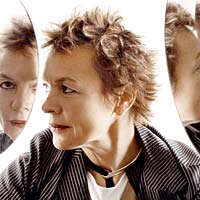|
Photo: Peter Ross |
| Laurie Anderson |
In 2002, the performance art pixie and Glen Ellyn native Laurie Anderson became NASA’s first resident artist. On November 20th and 21st, she brings The End of the Moon, the solo musical and spoken-word piece that grew out of the experience, to Fullerton Hall at the Art Institute of Chicago. She talked to Chicago about the project.
Q: It seems natural that NASA would pick you to be their first artist in residence. How’d it go?
A: I thought it was a prank when I got the call-I hung up on them. But it wasn’t, and I was excited to take the job. I was much more interested in them than they were in me, not for lack of curiosity but lack of time. They just all work so hard, and have crushing deadlines. But there was great, good energy, not like when you walk into a corporate environment and can tell that no one wants to be there. They didn’t really know what to do with me when I got there, since I was the first artist to take on that role.
Q: Did you find this lack of structure frustrating?
A: I didn’t know how to approach my project at the beginning, but once I got over the size of NASA, I decided, well, I’d take this piece by piece, and just look around. You really can’t generalize about the agency; it’s such an enormously huge operation and they deal in everything from nuts-and-bolts stuff like making tires to theoretical issues like the origins of the universe. For two years I visited sites, from Hubble to Mission Control in Houston, to the Jet Propulsion Lab in Pasadena, and what I created is sort of a long poem.
Q: The technical setup for this piece is much smaller compared to some of your previous blockbusters. What’s the difference for you?
A: Well, I can tour much more easily, and can plug it all in myself. I want to make big visual statements without five giant trucks of equipment and loads of assistants. Big shows need lots of people, and the tickets get really expensive, and I start thinking, What am I doing this for? I did do some really huge things in Japan for Expo 2005 this spring-huge screens, big sets, and all that-but that stuff just sits there. I love that my rig has gotten so small. It’s not quite my dream yet, though; it should get a bit smaller. Briefcase size would be great.
Q: The evening jumps around from trivialities like walking your dog and fixing your watch to big concepts like time and beauty, punctuated by violin solos. It’s a lot for an audience to process, isn’t it?
A: My work is anti-narrative, not built like most movies are. I really like that famous Godard quote, “A story should have a beginning, a middle, and an end . . . but not necessarily in that order.” Unless you’re some kind of drama queen who really tries to have everything work a certain way, monitoring crescendos and decrescendos, most people don’t live lives like that, and I just don’t work in that structure.
Q: In the piece, you talk about some sinister aspects of space research, such as military applications of nanotechnology, and the 1960s plan to test nuclear weapons on the moon. How did The End of the Moon go over with NASA?
A: I was nervous when they came to see it in D.C. [in October 2004], but I think they have a sense of humor about the whole thing. I’ve been invited to go to Star City, the cosmonaut training center in Russia, so that’s a really cool thing to come out of the experience. I’d like to work on the Greening of Mars project, which has a 10,000-year timeline. We’re ruining our world, the same old ways our ancestors did. Whether we blow ourselves up, poison ourselves, or-best case-there are just too many of us, Mars is the likely place to go. We are all going to die, but that’s easier to accept if you can connect and think about what is going to happen to the people coming after us. I feel like if I have made a contribution to going somewhere, then it’s easier to accept my role in human fate.



